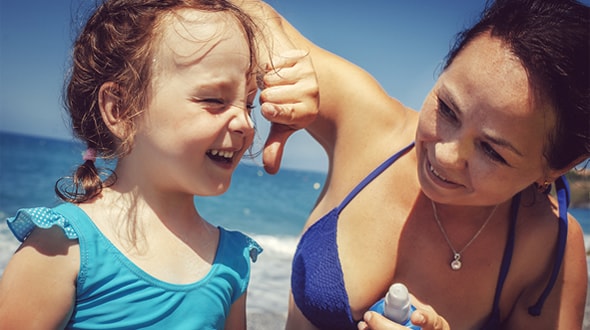Essential sun protection for children
Safeguard children from sun damage by starting early and teaching good habits for life.
Fit&Well blog
October 2016
According to SunSmart, “Childhood and adolescence are critical periods during which exposure to UV radiation is more likely to contribute to skin cancer in later life.”
The World Health Organisation, meanwhile, estimates around 80 per cent of our exposure to harmful UV rays occurs before we turn 18.

Slip, Slop, Slap, Slide, and Seek
Launched in 1981, recent generations of Aussies have grown up with the mantra of ‘slip on a shirt, slop on sunscreen, and slap on a hat’ as the golden rules of protecting ourselves from our country’s harsh sunlight.
In recent years, SunSmart has added ‘slide on some sunnies and seek some shade’ to that routine – and it’s an effective approach we need to teach our kids as early as possible.
Sensible fun in the sun
- observe the above precautions from September through to the end of April
- before you head out with your littlies, check UV levels on the SunSmart smartphone app
- choose a broad spectrum, water resistant sunscreen of SPF 30 or higher
- avoid hitting the pool, park or beach in the hottest parts of the day
- limit time in the sun between sunscreen reapplications, particularly in the water
- long-sleeve rash shirts are a great way to keep the entire torso and arms protected and may mean reapplying sunscreen less often to these areas.
Babies and toddlers
Children younger than six months should be kept out of the sun. A pram with an adjustable hood that covers the whole carriage will help protect your baby. Ideally, it should be made of densely woven fabric with a mesh section that blocks at least 70 per cent of UV radiation (UPF3.3). Always keep babies younger than 12 months in the shade during sunny weather and use age-appropriate sunscreen, and a hat to protect them from reflected light.
Don’t forget the eyes
While the skin is often the focus of most sun care advice, it’s important not to forget that young eyes can’t filter UV rays as effectively as adults. Children also tend to spend more time outside than adults and as such are exposed to triple the UV rays per year.
Too much sun on underdeveloped eyes can lead to increased risk of cataracts and macular degeneration as we age. Hats are ideal for shielding delicate eyes from direct sunlight. You may wish in invest in sunglasses but, before you do, keep in mind that all children’s sunglasses are not created equal. Choose:
- a well-fitting, wrap around style
- 100 per cent UVA and UVB filtering lenses that are also impact resistant
- sunnies that meet Australian standards and are labeled AS/NZS 1067:2003 or category two, three or four
- a soft elastic strap to secure them in place.
Toy or fashion sunglasses won't offer the same protection for your child’s eyes. Before investing, you may wish to book an appointment for an eye examination to check your child has no optical problems, so that the sunglasses you choose don’t do more harm than good.